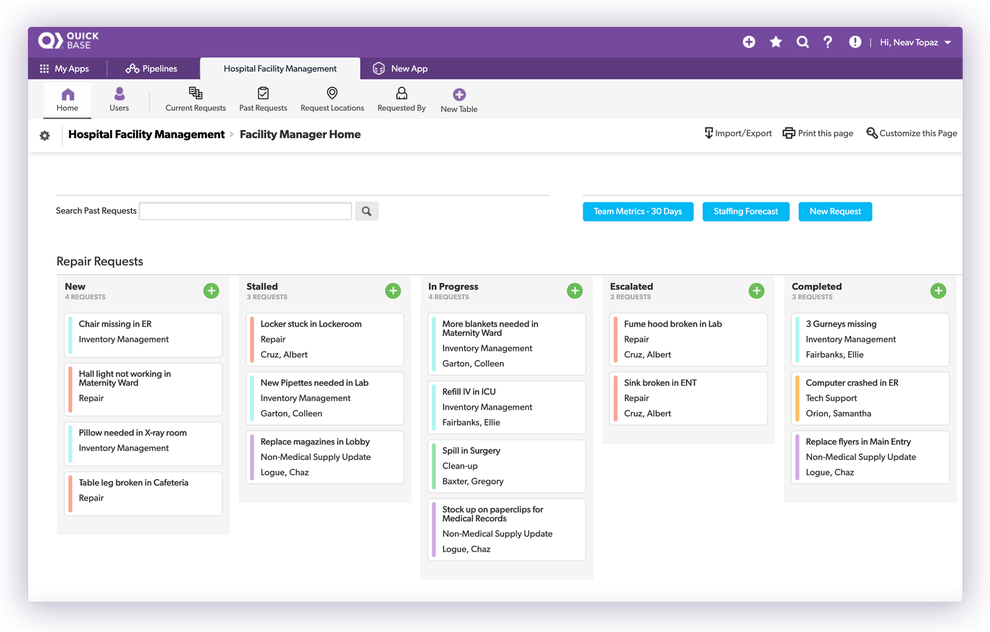5 Ways Businesses Can Use Low-Code Software to Scale Operations During COVID-19
Coronavirus has presented a new reality for all of us and forced millions of people globally to work remotely. Remote work comes with its set of opportunities and challenges. The pace at which businesses must adapt to today’s rapidly changing environment far outpaces the methods and resources available to support it. Businesses across all industries are finding new and innovative ways to scale their operations, help keep their employees safe and track assets and inventory.
One-way businesses are developing operational agility is by turning to low-code platforms. Low-code is a modern way to build and continually improve business software applications that better match the pace of change in today’s business environment.
The low-code application development method eliminates much of the tediousness associated with developing, deploying, maintaining, and updating applications built with traditional software development frameworks and techniques. It enables team members with little to no coding experience to build the applications they need themselves.The best low-code platforms unite teams across the business to continuously innovate and improve their operations.
During this time, some low-code software providers are helping businesses at the frontlines innovate and adapt quickly by offering their solutions and expertise for free.
How Low-Code Platforms Support COVID-19 Response
Here are 5 examples of low-code applications that businesses are developing to scale their operations and deal with COVID-19:
1. Quarantine and Test Tracking with Low-Code Applications
As healthcare organizations brace for an influx in confirmed cases, officials have advised many of those looking to get tested for COVID-19 to not go to the hospital. Instead, officials are instructing those who are experiencing symptoms to rather go to a drive-through testing site where you can be tested in your car.
It has become challenging to track the number of temporary testing sites, where they are located, how many testing sites must be built, the hours of operations, how many tests will be distributed, and how they will be staffed.
An initial analysis of COVID-19 related applications has found that healthcare organizations have invested in applications that can be used to track and manage the status of any testing or quarantine facility.
2. Request and Intake Management with Low-Code Applications
Stay-at-home orders have forced people to stay inside and only leave to get essential items. However, for vulnerable populations, it may be even more difficult to have access to the resources they need. Being able to connect people with the resources they need has become critically important as we learn to adjust to this new normal.
Companies are using low-code applications for tracking requests from citizens and consumers. These applications also allow for automated notifications, reminders, and updates.
3. Comprehensive Response Management with Low-Code Applications
Emergency response applications have been developed to address many of the unique problems that companies are encountering as it relates to COVID-19. This type of application allows companies to track assets assigned to employees or students during the crisis, as well as communicate with employees, customers or students and parents, as well as emergency response teams.
Based on some early insights, we have seen that many customers are creating these kinds of single applications to manage their end–to–end response to COVID-19.
For example, one manufacturing company has used such an application to track everything from employee cases to compliance with local COVID-19 restrictions across their plants to providing a regular communication hub for employees.
4. Asset Management with Low-Code Applications
Being remote is new for many companies and schools. While many have been able to quickly adjust to remote life, this has presented the challenge of how to track all your assets, like laptops and other necessary equipment, that don’t normally leave your office. IT asset tracking applications can also be built quickly using low-code software solutions.
Asset management applications are one of the most popular low-code applications seen during this time.
5. Managing Communication with Low-Code Applications
During business as usual communication with employees, customers or citizens is essential. Communication becomes critically important during a global pandemic.
It is essential that companies and governments can provide employees, customers and citizens with quick insight into new information and transparency into the constantly changing situation.
Communication focused applications have been popular among low-code software solution customers. Large cities have built applications to help manage calls to medical hotlines like tracking caller information, concerns from callers, or recommendations about any COVID-19 questions or those calling to report symptoms and seek guidance on how to get tested.
Companies have also used communication-focused applications to communicate with customers and employees as it may relate to store closures, event cancellations, and any other necessary information.
About the writer
Sunniya Saleem is the Senior Director, Demand Center and Digital Marketing at Quick Base, a low-code software solution provider. Sunniya is a senior go-to-market leader with years of experience building high-growth technology businesses. Prior to Quick Base, Sunniya was the Director of Demand Generation and Digital Marketing at Markforged, where she built the private equity-backed 3D printing software business’ digital presence, growth strategy and demand function from the ground up. Previously, she spent several years in SaaS and 3D CAD, leading digital programs at Dassault Systemes where she helped the SolidWorks brand expand on a multi-product strategy and regain its place as the leader in the market.
Sunniya holds a Master’s in Design and Brand Strategy from Brunel University, London. She also has a Bachelor of Arts in Design from London Metropolitan University.
Was this helpful?
